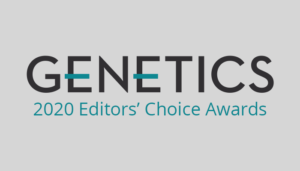Enter your address to receive notifications about new posts to your email.
Science & Publishing
-
Science & Publishing
New editors for Experimental Technologies and Resources section of GENETICS
GENETICS is pleased to announce four new editors for the Experimental Technologies and Resources section of the journal: Markus Affolter, Alejandro Sánchez Alvarado, Kristin Tessmar-Raible, and Julie Hayner Simpson. Markus Affolter Markus Affolter is a developmental biologist at the Biozentrum of the University of Basel and his lab has been interested in how cells form…
-
Science & Publishing
Introducing new Neurogenetics & Behavior editors to GENETICS
GENETICS is pleased to announce eight new editors for the Neurogenetics & Behavior section of the journal: Arantza Barrios, Tamara Caspary, Catherine Kaczorowski, Karla Kaun, Kyuhyung Kim, Roger Pocock, Hongyan Wang, and Jill Wildonger. Arantza Barrios Arantza Barrios is an Associate Professor/Reader in Neurobiology at University College London. Her lab uses the C. elegans male to investigate…
-
Science & Publishing
2021 Morgan Medal: Ruth Lehmann
One of life’s great mysteries is how a single egg cell can contain all the information needed to create a fully specialized complex organism, including more egg cells. Ruth Lehmann, director of the Whitehead Institute at MIT, has done a tremendous amount to solve that mystery. Beginning in her graduate student days, she uncovered a…
-
Science & Publishing
Strawberry detectives retrace family roots
Geneticists dig up the dirt on 300 years of succulence. When Steve Knapp started his new job at the University of California, Davis, he plunged into a forensic mystery that would take years to unravel. He wasn’t hunting a criminal or identifying a missing person, but the challenge before him was just as formidable: reconstructing…
-
Science & Publishing
Welcoming new Computational Resources, Software, & Databases editors to GENETICS
GENETICS is pleased to announce six new editors for the Computational Resources, Software, & Databases section of the journal: Anastasia Baryshnikova, Judith Blake, Michael Brent, Todd Harris, Marian Walhout, and Valerie Wood. Anastasia Baryshnikova Anastasia is a Principal Investigator at Calico Life Sciences LLC, an Alphabet-founded research and development company focused on understanding the biology of…
-
Science & Publishing
2021 Beadle Award: Ting Wu
After giving a talk in Seattle about chromosome pairing, Chao-ting (Ting) Wu boarded the redeye flight back to Boston and settled in to read a new research paper on an odd new discovery in the human genome. “It was so exciting, I had to get up and walk around on the plane,” she says. “I…
-
Science & Publishing
New editors for Molecular Genetics of Development section of GENETICS
GENETICS is pleased to announce five new editors for the Molecular Genetics of Development section of the journal: Daniela Drummond-Barbosa, Chi-Chung Hui, Hamed Jafar-Nejad, Elliot Meyerowitz, and Karuna Sampath. Daniela Drummond-Barbosa Daniela Drummond-Barbosa is a Professor in the Department of Biochemistry and Molecular Biology at Johns Hopkins University. Her research focuses on the physiological mechanisms…
-
Science & Publishing
Yeast regain long-lost traits
Yeast circumvent Dollo’s Law and reacquire traits lost tens of millions of years ago from distant relatives. Dollo’s Law, first proposed in the 19th century, holds that evolutionary losses are irreversible — if a species discards a complex trait, it will never reacquire exactly that trait. However, a study published in Genetics highlighted one way that unicellular fungi can…
-
Science & Publishing
Welcoming new Gene Expression section editors to GENETICS
GENETICS is pleased to announce three new editors for the Gene Expression section of the journal: Julie Claycomb, Joseph Bondy-Denomy, and Geraldine Seydoux. Julie Claycomb Julie Claycomb holds a longstanding interest in gene regulatory mechanisms involved in germline development. She started her lab in the Dept. of Molecular Genetics, University of Toronto, in 2011. She…
-
Science & Publishing
Three GENETICS articles from 2020 recognized with Editors’ Choice Awards
Congratulations to the winners of the Editors’ Choice Awards for outstanding articles published in GENETICS in 2020! The journal’s Editorial Board considered a diverse range of articles, finding many papers worthy of recognition. After much deliberation, they settled on one exceptional article for each of the three award categories: molecular genetics, population and evolutionary genetics,…
-
Science & Publishing
Sleep control gene conserved across millions of years of evolution
AP-2 transcription factors, which control sleep in flies and worms, are confirmed to do the same in mammals.







